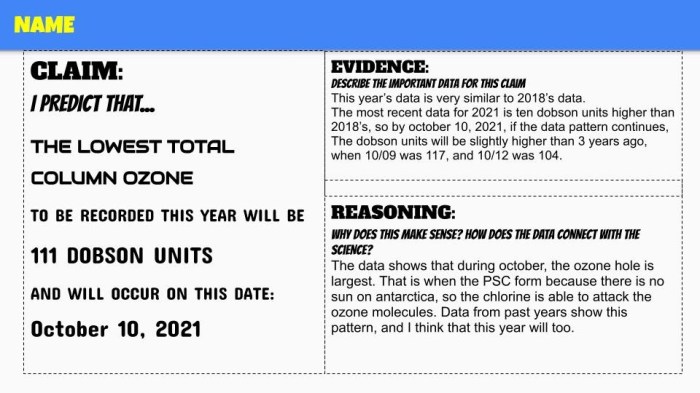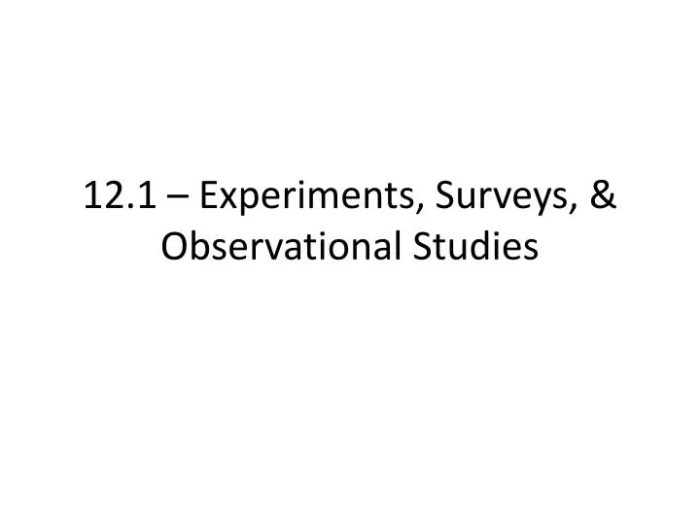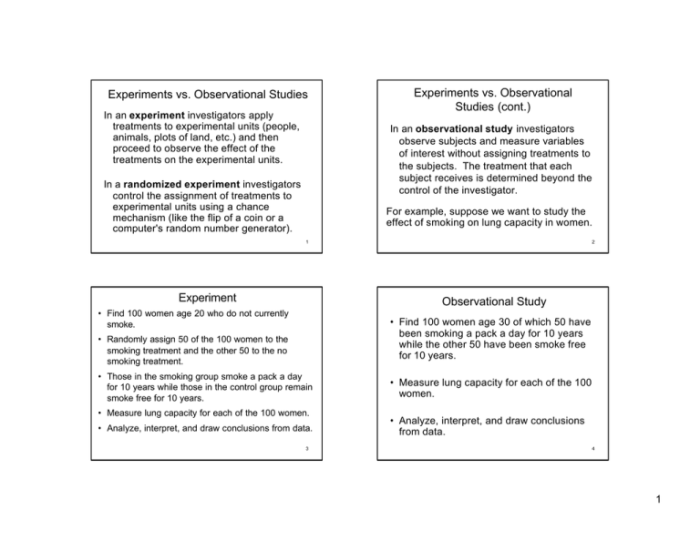Surveys experiments and observational studies worksheet answers – Unveiling the intricacies of research methodologies, this comprehensive guide delves into the realm of surveys, experiments, and observational studies. Embark on a journey to decipher their distinct characteristics, advantages, and limitations, equipping you with the knowledge to navigate the complexities of research design and execution.
As we delve into the nuances of each method, we’ll unravel the art of crafting effective surveys, meticulously designing experiments, and skillfully conducting observational studies. Through a blend of theoretical insights and practical applications, this guide empowers you to make informed decisions and extract meaningful conclusions from your research endeavors.
Surveys

Surveys are a research method used to collect data from a sample of individuals. They can be used to gather information about a wide range of topics, such as opinions, attitudes, and behaviors. There are many different types of surveys, including:
- Cross-sectional surveyscollect data from a sample of individuals at one point in time.
- Longitudinal surveyscollect data from the same sample of individuals over time.
- Cohort studiesfollow a group of individuals who have a common characteristic, such as being born in the same year.
- Case-control studiescompare a group of individuals who have a particular disease or condition to a group of individuals who do not.
Surveys have a number of advantages. They are relatively inexpensive to conduct, and they can be used to collect data from a large number of people. However, surveys also have some disadvantages. They can be subject to bias, and they may not be able to provide information about causal relationships.To
design a survey that will get the most accurate results, it is important to carefully consider the following factors:
- The target population: The target population is the group of individuals that you are interested in learning about.
- The sample size: The sample size is the number of individuals that you will survey.
- The survey questions: The survey questions should be clear and concise, and they should be designed to elicit the information that you are interested in.
- The survey method: The survey method is the way in which you will collect the data. There are a variety of survey methods available, including mail surveys, telephone surveys, and online surveys.
Experiments: Surveys Experiments And Observational Studies Worksheet Answers

An experiment is a research method used to test a hypothesis. A hypothesis is a statement about the relationship between two or more variables. Experiments are conducted by manipulating one or more independent variables and measuring the effect of this manipulation on one or more dependent variables.The
scientific method is a step-by-step process that is used to conduct experiments. The scientific method involves the following steps:
- Observation: The first step in the scientific method is to make an observation about the world around you.
- Hypothesis: Based on your observation, you develop a hypothesis about the relationship between two or more variables.
- Experiment: You conduct an experiment to test your hypothesis.
- Data analysis: You analyze the data from your experiment to see if it supports your hypothesis.
- Conclusion: Based on your data analysis, you draw a conclusion about the relationship between the variables.
There are many different types of experiments. The most common type of experiment is a controlled experiment. In a controlled experiment, the experimenter controls all of the variables that could affect the outcome of the experiment, except for the independent variable.
This allows the experimenter to isolate the effect of the independent variable on the dependent variable.Experiments are a powerful research method. They can be used to test hypotheses and to establish causal relationships. However, experiments can also be expensive and time-consuming to conduct.
Observational Studies

An observational study is a research method used to collect data about a group of individuals over time. Observational studies are often used to study the effects of a particular exposure on a particular outcome.There are two main types of observational studies:
- Prospective studiesfollow a group of individuals over time to see if they develop a particular outcome.
- Retrospective studieslook back at data from the past to see if there is a relationship between a particular exposure and a particular outcome.
Observational studies have a number of advantages. They are relatively inexpensive to conduct, and they can be used to collect data from a large number of people. However, observational studies also have some disadvantages. They can be subject to bias, and they may not be able to provide information about causal relationships.To
design an observational study that will get the most accurate results, it is important to carefully consider the following factors:
- The target population: The target population is the group of individuals that you are interested in learning about.
- The exposure: The exposure is the factor that you are interested in studying.
- The outcome: The outcome is the event that you are interested in studying.
- The study design: The study design is the way in which you will collect the data.
Worksheet Answers

- *1. What are the different types of surveys?
- Cross-sectional surveys
- Longitudinal surveys
- Cohort studies
- Case-control studies
2. What are the advantages and disadvantages of using surveys?Advantages:
- Relatively inexpensive to conduct
- Can be used to collect data from a large number of people
Disadvantages:
- Can be subject to bias
- May not be able to provide information about causal relationships
3. How do you design a survey to get the most accurate results?
Carefully consider the target population, sample size, survey questions, and survey method.
4. What is an experiment?
A research method used to test a hypothesis.
5. What are the different types of experiments?
- Controlled experiments
- Field experiments
- Natural experiments
6. How do you design an experiment to test a hypothesis?
Use the scientific method to develop a hypothesis, conduct an experiment, analyze the data, and draw a conclusion.
7. What is an observational study?
A research method used to collect data about a group of individuals over time.
8. What are the different types of observational studies?
- Prospective studies
- Retrospective studies
9. What are the advantages and disadvantages of using observational studies?Advantages:
- Relatively inexpensive to conduct
- Can be used to collect data from a large number of people
Disadvantages:
- Can be subject to bias
- May not be able to provide information about causal relationships
10. How do you design an observational study to get the most accurate results?
Carefully consider the target population, exposure, outcome, and study design.
Answers to Common Questions
What are the key differences between surveys, experiments, and observational studies?
Surveys rely on self-reported data, experiments involve manipulating variables to test hypotheses, and observational studies observe and analyze existing phenomena without intervention.
How can I design an effective survey to obtain accurate results?
Craft clear and concise questions, ensure anonymity, minimize bias, and pretest the survey for clarity and comprehension.
What are the advantages of using observational studies over experiments?
Observational studies offer insights into real-world phenomena without artificial manipulation, allowing researchers to observe natural behaviors and interactions.